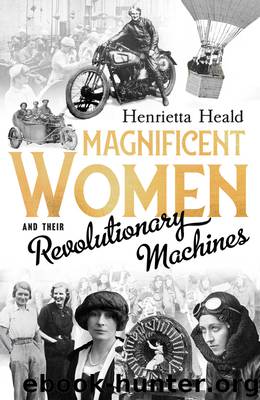Magnificent Women and their Revolutionary Machines by Henrietta Heald

Author:Henrietta Heald [Heald, Henrietta]
Language: eng
Format: epub
ISBN: 9781783526796
Publisher: Unbound
Published: 2019-06-27T16:00:00+00:00
NINE
The All-Electric Home
The creation in 1924 of the Electrical Association for Women – and her appointment as its first director – was a pivotal moment in Caroline Haslett’s life. It was the start of the realisation of her dream to transform human society through the power of science, as she explained in 1943: ‘One of the greatest scientific discoveries is electricity, bringing light, warmth and power. Here then was a force which would lighten the housewife’s labours, which would give us clean cities and would bring to the countryside the amenities of the town without spoiling the natural beauty. So we turned our attention to this most important side of engineering, because we felt that it held out so many hopes for humanity.’1
Caroline’s intention was to assemble a group of expert women to whom other women and electrical engineers alike could turn for advice and instruction.2 Education was a priority, with Margaret Partridge and others, including Caroline herself, giving lectures around the country and helping to raise awareness of the new venture in schools and among organisations such as the Girl Guides and the Women’s Institute. Evening classes were arranged for members already working in the electrical industry and as domestic science mistresses, and an Electrical Housecraft School would eventually be set up at 20 Regent Street, which from 1933 became the site of the association’s headquarters and clubroom. Caroline wanted all women to appreciate the wonders of science, to acquire electrical knowledge, and to have time to follow their own interests.
The backing of some well-established firms and individuals in the electricity industry helped to launch the new organisation, which began with very little money, though British Thomson-Houston Company, Metropolitan-Vickers Electrical Company and General Electric Company each provided a small amount of funding. Champions in Parliament included Lady Astor (Conservative) and Ellen Wilkinson (Labour) – and Caroline was thrilled when Lady Astor agreed to become the association’s first president. Over the years, a warm understanding developed between Caroline and Nancy Astor, whom Caroline described as ‘full of life and hope and joyous undertakings’, even though she sometimes found her lacking in spontaneity. Reflecting later how much she appreciated Nancy’s support for her various ventures, Caroline said, ‘Many a time [has] her sparkle invigorated and cheered me, and life always seems to have much more flavour when tasted in her company.’3
In June 1926 Caroline launched a magazine called the Electrical Age for Women (later shortened to the Electrical Age), which she continued to edit as long as she remained director of the association. ‘The Women’s Engineering Society and later the Electrical Association for Women allowed me to share the trials and tribulations of Fleet Street in a small way,’ she explained later. ‘The Woman Engineer is a quarterly given up in the main to technical subjects and the Electrical Age is also a quarterly, run on rather more popular lines.’
The spread of the Electrical Association for Women was immediate and rapid. The first branch opened in Glasgow in November 1925, spearheaded by Elizabeth Kennedy, managing director of the machine-tool manufacturer J.
Download
This site does not store any files on its server. We only index and link to content provided by other sites. Please contact the content providers to delete copyright contents if any and email us, we'll remove relevant links or contents immediately.
| Civilization & Culture | Expeditions & Discoveries |
| Jewish | Maritime History & Piracy |
| Religious | Slavery & Emancipation |
| Women in History |
Cecilia; Or, Memoirs of an Heiress — Volume 1 by Fanny Burney(32495)
Cecilia; Or, Memoirs of an Heiress — Volume 2 by Fanny Burney(31909)
Cecilia; Or, Memoirs of an Heiress — Volume 3 by Fanny Burney(31892)
The Secret History by Donna Tartt(18945)
Sapiens: A Brief History of Humankind by Yuval Noah Harari(14319)
Leonardo da Vinci by Walter Isaacson(13235)
The Radium Girls by Kate Moore(11970)
Sapiens by Yuval Noah Harari(5322)
How Democracies Die by Steven Levitsky & Daniel Ziblatt(5170)
The Wind in My Hair by Masih Alinejad(5056)
Homo Deus: A Brief History of Tomorrow by Yuval Noah Harari(4871)
Endurance: Shackleton's Incredible Voyage by Alfred Lansing(4719)
Man's Search for Meaning by Viktor Frankl(4502)
The Silk Roads by Peter Frankopan(4488)
Millionaire: The Philanderer, Gambler, and Duelist Who Invented Modern Finance by Janet Gleeson(4420)
The Rape of Nanking by Iris Chang(4165)
Joan of Arc by Mary Gordon(4053)
The Motorcycle Diaries by Ernesto Che Guevara(4050)
Hitler in Los Angeles by Steven J. Ross(3923)
